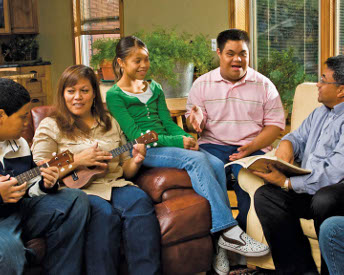Difference between revisions of "Mormon Youth"
Dennisangot (talk | contribs) |
Dennisangot (talk | contribs) |
||
| Line 1: | Line 1: | ||
| − | [[Image:mormon-education3.jpg|left| | + | [[Image:mormon-education3.jpg|left|350px|alt=Mormon youth in a church seminary class]] |
'''Mormon Youth''' stand out from the youth of the world and the youth of other churches for the depth of their involvement in church function, the depth of their knowledge and testimony of [[Jesus Christ]], and for their goals and standards. An article on BeliefNet.com called "Flunking Sainthood," by Jana Riess, [http://blog.beliefnet.com/flunkingsainthood/2010/08/mormonism-protestantism-and-the-american-teenager-a-review-of-kenda-creasy-deans-almost-christian.html] compares American Protestant youth with young U.S. members of [[The Church of Jesus Christ of Latter-day Saints]]. The article cites a report in USA Today [http://www.usatoday.com/news/religion/2010-08-11-teenchurch10_ST_N.htm?csp=34news] which shows that youth attendance at Protestant youth group functions is falling radically, now down to 1 in 4. "This all has [Protestant] churches canceling their summer teen camps and youth pastors looking worriedly toward the fall, when school-year youth groups kick in....A decade ago teens were coming to church youth group to play, coming for the entertainment, coming for the pizza. They're not even coming for the pizza anymore. They say, 'We don't see the church as relevant, as meeting our needs or where we need to be today.'" | '''Mormon Youth''' stand out from the youth of the world and the youth of other churches for the depth of their involvement in church function, the depth of their knowledge and testimony of [[Jesus Christ]], and for their goals and standards. An article on BeliefNet.com called "Flunking Sainthood," by Jana Riess, [http://blog.beliefnet.com/flunkingsainthood/2010/08/mormonism-protestantism-and-the-american-teenager-a-review-of-kenda-creasy-deans-almost-christian.html] compares American Protestant youth with young U.S. members of [[The Church of Jesus Christ of Latter-day Saints]]. The article cites a report in USA Today [http://www.usatoday.com/news/religion/2010-08-11-teenchurch10_ST_N.htm?csp=34news] which shows that youth attendance at Protestant youth group functions is falling radically, now down to 1 in 4. "This all has [Protestant] churches canceling their summer teen camps and youth pastors looking worriedly toward the fall, when school-year youth groups kick in....A decade ago teens were coming to church youth group to play, coming for the entertainment, coming for the pizza. They're not even coming for the pizza anymore. They say, 'We don't see the church as relevant, as meeting our needs or where we need to be today.'" | ||
| Line 13: | Line 13: | ||
Those four things as explained by Dean, are... | Those four things as explained by Dean, are... | ||
| − | [[Image:mormon-families4.jpg|right| | + | [[Image:mormon-families4.jpg|right|350px|alt=A Mormon "Family Home Evening"]] |
:*Mormon youth are taught both by church programs and home-based programs their core doctrines, and indeed, all the beliefs of the Church. The [[seminary]] teaches doctrine on a daily basis. Students in Utah attend during the school day, and elsewhere youth attend early morning religion classes every school day. These classes go all the way through the scriptures and explain doctrine and lifestyle choices in detail. This learning is reinforced at home through family scripture reading, family prayer, and weekly [[Family Home Evening|family home evenings]]. "Mormon teens are nearly twice as likely (79%) as other teens to pray with their parents at times other than grace for meals." | :*Mormon youth are taught both by church programs and home-based programs their core doctrines, and indeed, all the beliefs of the Church. The [[seminary]] teaches doctrine on a daily basis. Students in Utah attend during the school day, and elsewhere youth attend early morning religion classes every school day. These classes go all the way through the scriptures and explain doctrine and lifestyle choices in detail. This learning is reinforced at home through family scripture reading, family prayer, and weekly [[Family Home Evening|family home evenings]]. "Mormon teens are nearly twice as likely (79%) as other teens to pray with their parents at times other than grace for meals." | ||
| Line 20: | Line 20: | ||
:*Mormon youth develop a concrete set of religious goals and a "sense of vocation." "Part of the problem that Dean is diagnosing in American Protestantism is that there's nothing teens are working toward, no sense of spiritual growth being a closely monitored goal. Much of that seems to end with confirmation around age twelve or thirteen, which is an invitation to drop out." In Mormonism kids prepare for missions and the [[Mormon Temples|temple]]. Mormon children begin [[fasting]] with the community at age 8 and may stand up and speak about their testimony of Christ from the time they can talk. Children pay [[tithing]] and learn the doctrine behind the practice. They participate in service projects and keep track of their service in journals. Boys work toward becoming Eagle Scouts and also work on Duty to God awards. Girls track their participation, development of character, and service as they work toward Young Women of Excellence awards. | :*Mormon youth develop a concrete set of religious goals and a "sense of vocation." "Part of the problem that Dean is diagnosing in American Protestantism is that there's nothing teens are working toward, no sense of spiritual growth being a closely monitored goal. Much of that seems to end with confirmation around age twelve or thirteen, which is an invitation to drop out." In Mormonism kids prepare for missions and the [[Mormon Temples|temple]]. Mormon children begin [[fasting]] with the community at age 8 and may stand up and speak about their testimony of Christ from the time they can talk. Children pay [[tithing]] and learn the doctrine behind the practice. They participate in service projects and keep track of their service in journals. Boys work toward becoming Eagle Scouts and also work on Duty to God awards. Girls track their participation, development of character, and service as they work toward Young Women of Excellence awards. | ||
| − | [[Image:mormon-praying-boy.jpg|left| | + | [[Image:mormon-praying-boy.jpg|left|150px|alt=Mormon Boy Praying]] |
:*Mormon youth develop hope for the future, which is absolutely necessary for a deepening of faith. Mormon teens talk confidently of the purpose of life. They have concrete goals that stretch out into the eternities. | :*Mormon youth develop hope for the future, which is absolutely necessary for a deepening of faith. Mormon teens talk confidently of the purpose of life. They have concrete goals that stretch out into the eternities. | ||
Revision as of 22:50, 10 September 2010
Mormon Youth stand out from the youth of the world and the youth of other churches for the depth of their involvement in church function, the depth of their knowledge and testimony of Jesus Christ, and for their goals and standards. An article on BeliefNet.com called "Flunking Sainthood," by Jana Riess, [1] compares American Protestant youth with young U.S. members of The Church of Jesus Christ of Latter-day Saints. The article cites a report in USA Today [2] which shows that youth attendance at Protestant youth group functions is falling radically, now down to 1 in 4. "This all has [Protestant] churches canceling their summer teen camps and youth pastors looking worriedly toward the fall, when school-year youth groups kick in....A decade ago teens were coming to church youth group to play, coming for the entertainment, coming for the pizza. They're not even coming for the pizza anymore. They say, 'We don't see the church as relevant, as meeting our needs or where we need to be today.'"
Two other books from Oxford, Soul Searching and Souls in Transition, reveal that though "American youth profess belief at a high level (in God, the afterlife, and the Bible), their level of religious practice does not typically match what they say they believe."
The article also reviews Kenda Creasy Dean's book, Almost Christian:What the Faith of our Teenagers is Telling the American Church. Dean says that "teenagers in Protestant churches get the idea that they're supposed to feel good about themselves, but that little is expected of them; Christianity is designed to make them "nice," but it's not supposed to form them as disciples." Dean claims that youth "are being taught a brand of Christianity that is a mile wide and an inch deep."
Mormon Envy
One of the chapters in Dean's book is called "Mormon Envy." Dean holds up Mormonism as the religion that is doing right by its teenagers. "Mormonism is succeeding in creating young adults who firmly understand what they believe and why their faith needs to have a claim on their behavior. She says that Mormonism is giving teens the four things they need in order to have a growing adult faith."
Those four things as explained by Dean, are...
- Mormon youth are taught both by church programs and home-based programs their core doctrines, and indeed, all the beliefs of the Church. The seminary teaches doctrine on a daily basis. Students in Utah attend during the school day, and elsewhere youth attend early morning religion classes every school day. These classes go all the way through the scriptures and explain doctrine and lifestyle choices in detail. This learning is reinforced at home through family scripture reading, family prayer, and weekly family home evenings. "Mormon teens are nearly twice as likely (79%) as other teens to pray with their parents at times other than grace for meals."
- Mormon youth are taught that they need to acquire a sincere and deeply rooted personal testimony that Jesus is the Christ and that the doctrines of the Mormon Church are true. Mormon youth are expected to put their faith into action by serving in the Church. The Church has a lay clergy and members serve in every capacity. Youth are expected to serve, and they began as little children. According to Dean, more than half of LDS youth reported giving a talk or presentation in church within the previous six months (compared to one in seven Southern Baptist youths and one in twenty-five Catholics). 48% of Mormon youth reported making a leadership decision that would be binding on a group. These experiences pave the way for other crucial "faith-forming" events, such as serving a full-time mission for the Church. Youth develop skills that help them share their faith, provide service and leadership, understand doctrine, and feel the promptings of the Holy Ghost.
- Mormon youth develop a concrete set of religious goals and a "sense of vocation." "Part of the problem that Dean is diagnosing in American Protestantism is that there's nothing teens are working toward, no sense of spiritual growth being a closely monitored goal. Much of that seems to end with confirmation around age twelve or thirteen, which is an invitation to drop out." In Mormonism kids prepare for missions and the temple. Mormon children begin fasting with the community at age 8 and may stand up and speak about their testimony of Christ from the time they can talk. Children pay tithing and learn the doctrine behind the practice. They participate in service projects and keep track of their service in journals. Boys work toward becoming Eagle Scouts and also work on Duty to God awards. Girls track their participation, development of character, and service as they work toward Young Women of Excellence awards.
- Mormon youth develop hope for the future, which is absolutely necessary for a deepening of faith. Mormon teens talk confidently of the purpose of life. They have concrete goals that stretch out into the eternities.
Faith and Life
There are interesting statistics on teen pregnancy and religious conservatism. One study shows that teen pregnancy rates are highest in the most religious conservative states in America. Utah is the one exception. It rates 6th in religious conservatism, but 34th for teen pregnancy. Mormons make up about 62% of Utah's population. (See Law of Chastity.) Something about concrete religious goals, involvement in service, learning doctrine, developing personal testimony, and support from church and home, help Mormon teens to lead moral lives. Not only are they striving to live the Law of Chastity, increasingly difficult in today's world, but they also strive to be honest and to live according to the Word of Wisdom, the health laws of the Church.
- See also MormonYouth.org


